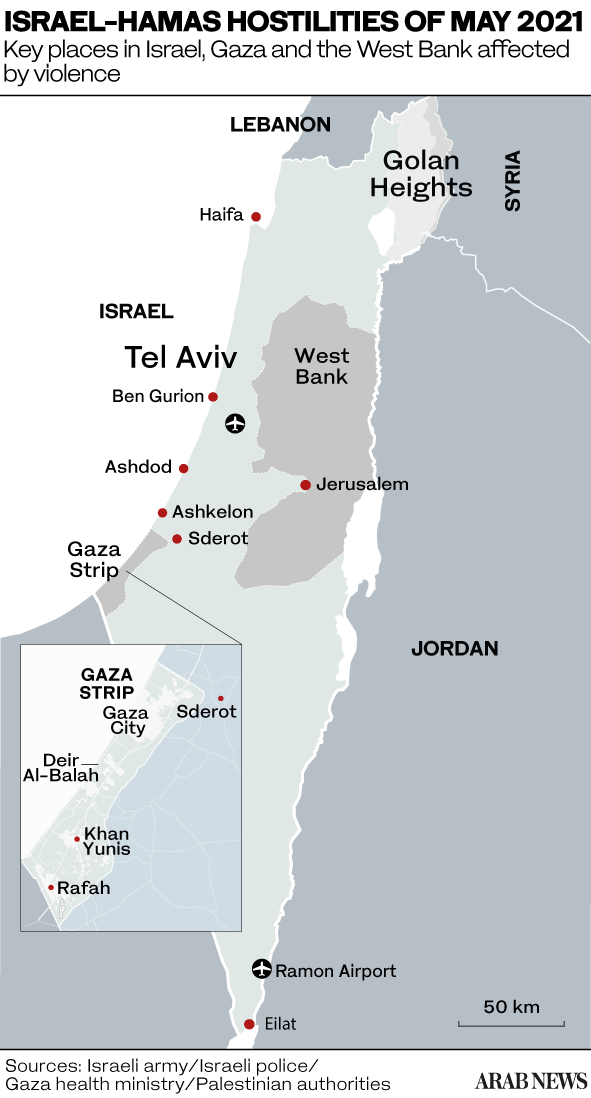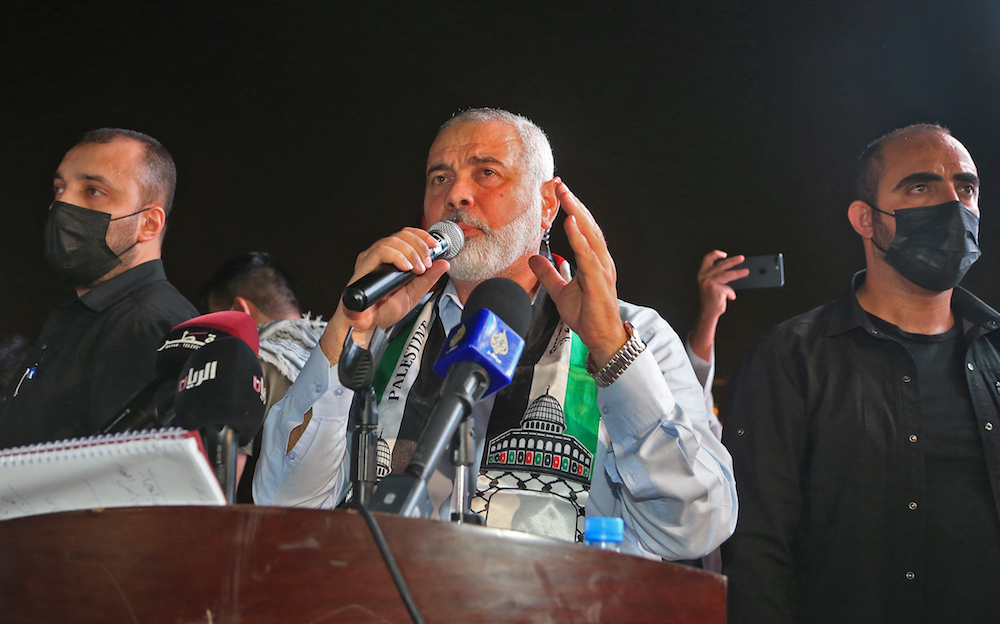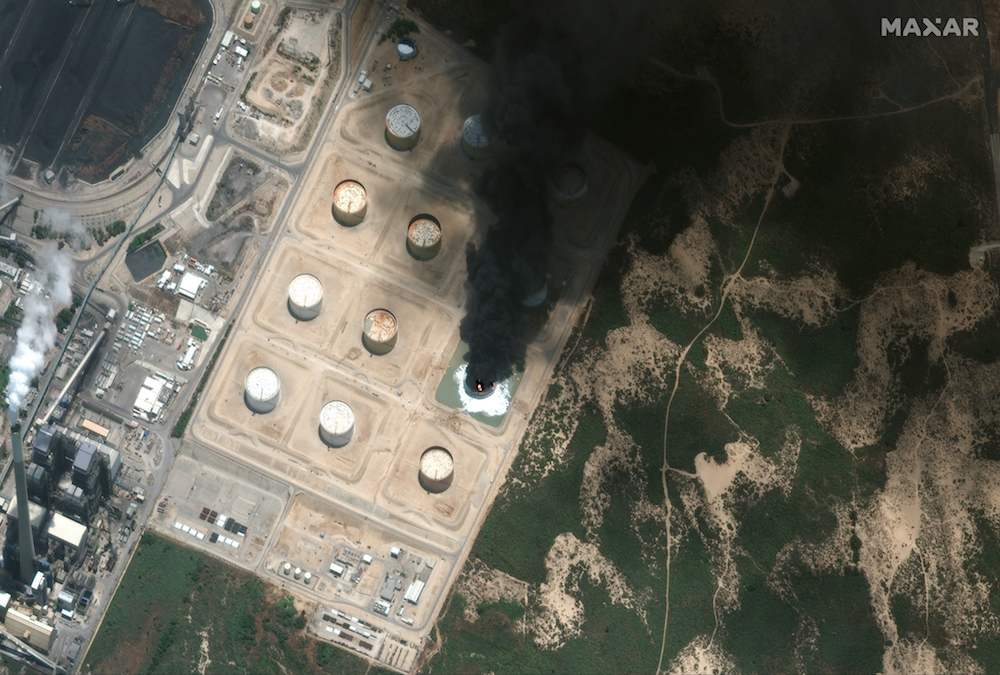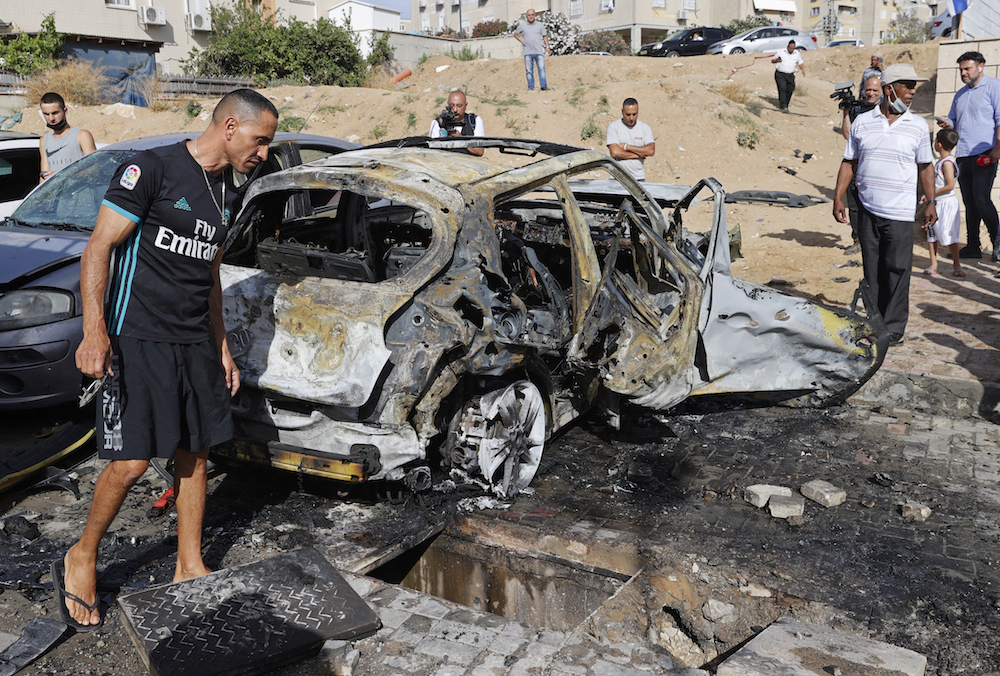DUBAI: As an Egypt-brokered ceasefire between Israel and Hamas came into effect early on Friday morning, Palestinians in the Gaza Strip were again left surveying the devastation wrought by 11 days of intense air and artillery bombardment.
United Nations Secretary-General Antonio Guterres lamented the “senseless cycle of bloodshed, terror and destruction,” adding that the hostilities had caused serious damage to vital civilian infrastructure in Gaza, which he described as “hell on earth” for children.
Even so, there is widespread relief that the conflict, in which at least 232 Palestinians and 12 Israelis were killed, has ended after less than two weeks — compared with the seven weeks of the 2014 ground incursion which left more than 2,000 dead — and that the latest hostilities, for the most part, did not spread into the West Bank.

Palestinian artist Bilal Khaled draws on an unexploded device in Gaza City on May 20, 2021. (AFP)
In both the West Bank and Gaza, political and diplomatic processes are deadlocked. In April, President Mahmoud Abbas postponed legislative and presidential elections in the Palestinian territories. Most observers believe he did so for fear that Hamas would win. Abbas was elected in 2005 but has ruled by decree for more than a decade since his last mandate expired.
Hamas has controlled the Gaza Strip since shortly after the last elections in 2006. It has steadfastly refused to recognize Israel’s right to exist. Both its political and military arms are categorized as a terrorist organization by the US and European Union.
“The peace camp needs to be rebuilt from the ground up,” Taufiq Rahim, a senior fellow in international security at the New America think tank, told Arab News. “Too many in Israel view calm as peace when, in reality, it is simply a state of prolonged injustice for Palestinians.”

Meanwhile, the status of East Jerusalem remains unresolved, and Israel’s settlement of the West Bank — which it captured along with the Gaza Strip in 1967 — continues.
Abdulkhaleq Abdulla, a former chairman of the Arab Council for Social Sciences, says it is clear that Israeli settlers instigated the most recent outbreak of violence, which started in the Sheikh Jarrah neighborhood in East Jerusalem.
“The government of Israel could have controlled it, but apparently encouraged it,” he told Arab News. “This is consistent with patterns of aggression that we have seen over the past seven years of clashes.”

Hamas' political bureau chief Ismail Haniyeh addresses supporters in Qatar in May, 2021. (AFP)
Other experts highlighted the fact that Palestinian protests and discontent spread to Arab neighborhoods inside Israel. Fighting broke out in Israeli and Arab towns including Jaffa, Ramleh and Lod, in the course of which Palestinian and Hamas flags were raised and synagogues and hospitals attacked.
Those towns and others, such as Haifa, Nazareth and Acre, have sizeable Arab populations — the descendants of those who stayed inside the so-called Green Line when the state of Israel was created in 1948. Many have Israeli citizenship and the right to vote in Israeli elections.
“This crisis has brought the conflict back to its roots, which are in the dispossession of the refugees in 1948,” Nadim Shehadi, an associate fellow at Chatham House, told Arab News. “Protests on this scale inside Israel have not been seen (before), even during the second intifada.”

That uprising gripped much of the Gaza Strip and West Bank from 2000 to 2005, during which time there were only sporadic incidents of violence in these towns. In 2021 that changed.
Benjamin Netanyahu, the Israeli prime minister, was forced to declare a state of emergency in Lod, the first time such powers have been invoked in a town inside Israel since 1966, according to Israeli media.
Illustrating the complexity of the situation, in one incident the clashes seemed in part to have been provoked by the death of an Arab man and his child after a rocket fired by Hamas from inside Gaza destroyed his car.
Hamas — which has widespread support throughout the Palestinian territories — remains in a combative mood.
“The whole world should know that our hands are on the trigger and we will continue to grow the capabilities of this resistance,” a Hamas spokesman told Reuters shortly before the ceasefire.
The scale of those capabilities has come as a surprise to many. Analysts speaking to Arab News highlighted the group’s apparently large arsenal of missiles and drones and, perhaps, fabrication capabilities created with Iranian help as major developments.
Over the 11 days of fighting this month, Hamas is estimated to have fired more than 4,300 missiles into southern and central Israel, a far more intensive barrage than in the 2014 conflict and heavier than Hezbollah’s bombardment from Lebanon during the 2006 war.
Israeli officials said that 90 percent of the incoming volleys were intercepted by the Iron Dome air-defense system, but believe that thousands more missiles still remain in the Hamas arsenal. The Iron Dome system, which has been deployed since 2011 and maintained by US funding of $1.6 billion, was used in previous conflicts, but Hamas had never fired so many rockets simultaneously.
The Israeli military (IDF) said that as many as one in seven of the missiles fired by Hamas landed inside Gaza itself and accused Hamas of indiscriminate targeting of civilians there and inside Israel.

This handout satellite image released by Maxar Technologies shows a closer view of a burning storage tank in Ashkelon Southern Israel on May 12, 2021. (AFP)
“The attacks (by Hamas) in Gaza by themselves have revealed a level of preparation that exceeded expectations in terms of the quantity and quality of missiles, with respect to their range, ability to head deep into Israel territory, and the variety of the weapons on hand, such as drones,” Riad Kahwaji, a UAE-based defense analyst, told Arab News. “All of these make the latest round of violence unique.”
In the longer term, the status of the Abraham Accords — a major agreement signed by Israel, the UAE and the US in August last year — is likely to come under scrutiny. Shortly after the deal was signed, Bahrain, Sudan and Morocco also recognized Israel formally.
The UAE has gone on to sign a series of investment agreements with Israel and opened direct air links. Both Israel and the UAE have opened embassies in their respective countries.

Palestinian President Mahmoud Abbas speaks during an emergency meeting of the Fatah Central Committee and the PLO Executive Committee in the occupied West Bank City of Ramallah, on May 12, 2021. (AFP)
Critics of Hamas and its links to the Muslim Brotherhood and Iran say that the group amassed its missile arsenal and initiated the fighting specifically to undermine the Abraham Accords, which all of them view as a threat. Bassem Eid, a human rights activist, has said Hamas sought to exploit a local dispute in East Jerusalem in order to undermine the Abraham Accords.
There is certainly no denying that the 11 days of fighting were a testing time for the accord.
“The hope and the fanfare surrounding the signing of the agreement petered out with the smoke from Gaza,” said Dr. Albadr Al-Shateri, a former professor of politics at the National Defense College in Abu Dhabi. “The conflict, far from re-establishing Israel’s (strength), exposed its vulnerabilities.”

Onlookers gather around charred vehicles hit by rockets launched by Hamas militants from the Gaza Strip in the southern Israeli city of Ashkelon on the border with the Palestinian coastal enclave on May 16, 2021. (AFP)
Going forward, he believes the US, Europe, and the GCC countries can assist in improving Palestinian lives in the Occupied Territories and within Israel. “More investment to provide jobs, rebuilding the infrastructure, and improvement of the health and educational systems, among other things, will help to create the conditions for a negotiated settlement,” he told Arab News.
According to New America’s Rahim, while Israel has developed deeper relationships in the Arab world, public opinion in the US is likely to be critical, given the apparent shift in the sentiments of politicians and the wider population there.
The reality of the situation is that there is a vacuum in new leadership in both Israel and Palestine, with radicals on both sides being the only actors visible on the horizon at present, he told Arab News.
“There needs to be new leaders in both Palestine and Israel who can imagine coexistence rather than conflict as a potential future.”
-----------------
Twitter: @CalineMalek

























